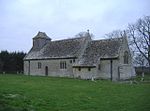All Saints Church, Leigh
14th-century church buildings in EnglandChurch of England church buildings in WiltshireGrade II* listed churches in Wiltshire

All Saints Church was built around 1250 at Leigh, north Wiltshire, England, and was originally on a site half a mile to the north of its current location. In 1896, the nave, porch and bell tower were moved from their original location and a new church was built, which is now Grade II* listed. The chancel and the east gable of the old nave remain in the old churchyard as All Saints Chancel.
Excerpt from the Wikipedia article All Saints Church, Leigh (License: CC BY-SA 3.0, Authors, Images).All Saints Church, Leigh
Swan Lane,
Geographical coordinates (GPS) Address Nearby Places Show on map
Geographical coordinates (GPS)
| Latitude | Longitude |
|---|---|
| N 51.628333333333 ° | E -1.9113888888889 ° |
Address
All Saints Graveyard
Swan Lane
SN6 6RD
England, United Kingdom
Open on Google Maps










